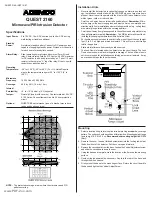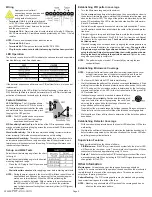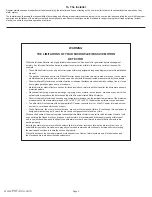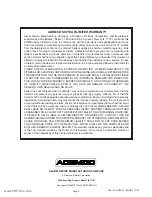
Installation Hints
•
Never install the detector in a location that causes an alarm in one technol-
ogy. Installations should start with the LED OFF when no target motion is
present. Never leave it to operate with the tri-color LED in a constant or inter-
mittent green, yellow, or red condition.
•
Point the unit away from outside traffic (roads/alleys). Remember: Micro-
wave energy will pass through glass and most common non-metallic con-
struction walls. Avoid installations where rotating machines (e.g., ceiling fans)
are normally in operation within the coverage pattern.
•
Point the unit away from glass exposed to the outdoors and objects that may
change temperature rapidly. Remember: The PIR detector will react to ob-
jects rapidly changing temperature within its field-of-view.
•
For hostile environments due to nearby traffic, mount the unit seven to eight
feet (2 to 2.5 m) high and aimed downward. This will form a short-range
interior trap pattern.
•
Eliminate interference from nearby outside sources.
•
The Look Down is located under the detector on the circuit board. The Look
Down zone is shown in black in the pattern drawings. The Look Down lens is
not recommended for installations containing pets or small animals. It may
be masked with tape like the other zones.
Mounting
1. Select a location likely to intercept an intruder moving across the coverage
pattern. The surface should be solid and vibration-free. Mounting height range
is six to eight ft. (1.8 to 2.4 m). Recommended mounting height is 6-1/2 ft.
(2 m).
2. Remove the cover. Insert a flathead screwdriver into the locking tab hole at
the bottom front of the detector. Pull the cover up and forward.
3. Remove the circuit board from the base. Loosen the Vertical Adjustment screw
and slide the circuit board down then out.
4. Using the base as a template, mark the location of the holes on the mounting
surface.
5. Route wiring (unpowered) as necessary. Route to the rear of the base and
through the wire entrance.
6. Firmly mount the base to the mounting surface. Return the circuit board to
the base and tighten the Vertical Adjust Screw.
QUEST 2160-INST 12/97
QUEST 2160
Microwave/PIR Intrusion Detector
Specifications
Input Power:
9 to 15 VDC, 16 mA DC nominal (up to 48 mA DC during
walk testing or trouble conditions).
Standby
Power:
No internal standby battery. Connect to DC power sources
capable of supplying standby power. Sixteen mA-H required
for each hour of standby time needed.
Alarm Relay:
Silent operating normally closed/common (Form A) reed
relay. Contacts rated 3 watts, 0.125 amps, 28 VDC maximum
for DC resistive loads, and protected by a 4.7 ohm, 1/2 watt
resistor in the common “C” leg of the relay.
Do not use with
capacitive or inductive loads.
Operating
Temperature:
-40° to +120°F (-40° to +49°C). For U.L. Listed Require-
ments, the temperature range is +32° to +120°F (0° to
+49°C).
Microwave
Frequency:
10.525 Ghz ± 25.000 MHz.
Coverage:
60 ft. by 60 ft. (18 m by 18 m).
Internal
Pointability:
+2° to –10° Vertical, ±10° Horizontal.
Tamper:
Normally Closed (with cover on). Contacts rated at 28 VDC,
0.125 A max. Connect tamper circuit to 24 hour protection
circuit.
Options:
QUEST SB2 swivel bracket (use of a bracket may reduce
range and dead zone area).
NOTE: The protected coverage area is where the microwave and PIR
patterns overlap.
www.PDF-Zoo.com






















